So, are fake plants tacky or trendy? Maybe you’re picturing your grandma’s old plastic fern gathering dust, but honestly, today’s fake plants have totally changed the game.
If you pick the right ones and use them with a bit of style, fake plants can look incredibly modern and chic.
Table of Contents
Artificial foliage used to get a bad rap for looking cheap or being everywhere, but lately, things have shifted.
People now use quality faux greenery in all sorts of spaces, from tiny apartments to swanky office lobbies. Some of these plants look so real, guests do a double take.
If you’re unsure about making the switch, you’re definitely not alone.
I swapped out my real fiddle leaf fig for a well-made fake after battling droopy leaves, and nobody even noticed. The trick is to focus on quality, smart placement, and your personal style.
Let’s break down the pros and cons, share some easy tips, and see if fake plants could actually work in your home.
Key Takeaways
- Fake plants can be trendy and practical, if you pick wisely.
- Quality, looks, and placement decide if faux greenery feels stylish or tacky.
- You get style and maintenance-free living with artificial plants.
Understanding Fake Plants: Defining the Trend
Fake plants are popping up everywhere these days, from your neighbor’s windowsill to hip cafés downtown.
A lot of folks wonder if they actually look good or just end up as dust magnets. Knowing what counts as a fake plant and which styles people love can help you decorate smarter.
What Qualifies as a Fake Plant?
A fake plant is basically any plant made from materials like plastic, silk, polyester, or even paper—nothing grown from soil.
Stores call them artificial plants, faux plants, or decorative greenery. Some even use “real touch” tech, so the leaves feel surprisingly lifelike.
You’ll often spot fake plants in places where sunlight barely reaches. Since they never wilt or need water, they fit busy routines or awkward corners perfectly.
Some look super realistic; others, well, not so much. That’s what can make them feel trendy or just plain tacky.
I’ve seen friends stick faux foliage on top of kitchen cabinets—real plants just dry out up there.
If you dust them gently now and then, fake plants can last for years, adding a pop of green with zero hassle.
Popular Types: From Faux Flowers to Hanging Plants
Not all fake plants are created equal. Here’s a quick table of the most popular types and where you’ll usually find them:
| Type | Common Materials | Typical Use |
|---|---|---|
| Faux Flowers | Silk, Plastic, Paper | Vases, Bouquets |
| Artificial Foliage | Polyester, Plastic | Shelves, Walls |
| Hanging Plants | Plastic, Fabric | Ceilings, Baskets |
| Mini Succulents | Plastic, Resin | Desks, Windowsills |
Faux flowers are a favorite if you want color that sticks around all year.
You could pop silk tulips in a vase for a spring vibe or brighten up a bathroom with artificial blooms.
Hanging fake plants are also having a moment, especially for folks chasing that “indoor jungle” look but lacking a green thumb.
Even big box stores now offer plastic ivy or pothos that drape pretty convincingly.
If you’re looking for inspo, you’ll spot these in magazines and design blogs as easy ways to freshen up a dull spot.
Some people add faux greenery to gallery walls or tuck mini succulents among books for a modern touch.
If you don’t want to fuss, just wipe them down every few weeks to keep dust away.
Aesthetics and Appeal: Natural Look Versus Artificial Vibe
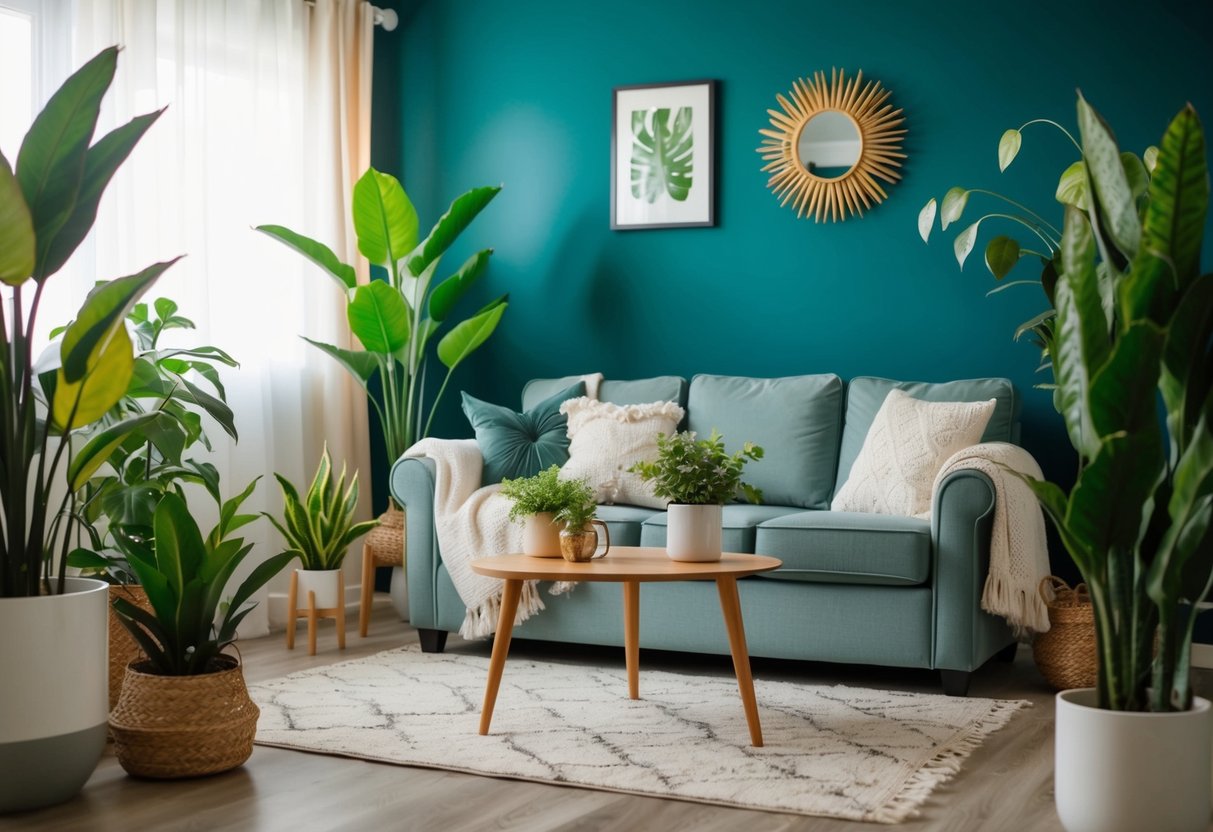
Fake plants spark a lot of debate in home decor. Some folks love how greenery brightens a space, while others worry that fake plants might ruin the vibe.
Pick the right ones, though, and your place can look fresh and on-trend. It’s all in the details.
Achieving a Realistic Appearance
Making artificial plants look real is the big challenge. Cheap versions use shiny plastic that screams “fake” and can make a space feel dated.
But high-quality faux greenery has improved a lot. The best ones use silk or soft fabrics, with textures and colors that look and feel like the real deal.
I once watched my aunt water a faux snake plant at my house—she had no idea it wasn’t alive!
Designers say, if you choose carefully, fake plants blend right in and even boost your aesthetic.
Focus on details like color variation and texture. Look for realistic roots, soil, or moss at the base.
Quality really does matter if you want that natural look.
Styling with Greenery: Tips and Visual Tricks
Styling makes all the difference with fake plants. Too many in one spot can look weird and unnatural.
But with a few tricks, you can keep your place feeling fresh.
- Mix real and fake: Blend a couple of real plants with your faux ones. It keeps people guessing and gives you lush vibes without all the work.
- Upgrade the pots: Use stylish planters or woven baskets to make fake plants look more upscale.
- Play with size: Mix tiny succulents on shelves with bigger floor plants for a balanced look.
- Spread them out: Don’t group all your faux greenery together. Scatter them around your home for a more natural feel.
Lighting helps, too. Place fake plants where they’d get natural light or where shadows hide any plastic shine.
I’ve noticed my living room corner always fools visitors—probably because my fake fiddle leaf fig sits right where a real one would, soaking up that soft light.
With smart placement and a little thought, artificial plants can feel like a real part of your decor.
For more ideas, check out this chat about styling faux greenery.
Are Fake Plants Tacky Or Trendy? The Social Perception Debate
Fake plants have a reputation that’s all over the place.
Some people call them cheap and outdated. Others love the hassle-free greenery and all the cool styles you can find now.
Your take on artificial plants probably depends on trends, your own taste, and how you decorate.
Evolving Attitudes: From Embarrassment to Acceptance
Not too long ago, plastic plants in your living room meant you were definitely not winning any style points.
You might remember your aunt’s dusty silk flowers on the coffee table—no one thought they were real.
That cringe factor came from years of bad designs and cheap fakes.
But things really have changed.
New artificial plants use better materials and smarter design. You can now find faux succulents and hanging vines that fool even die-hard plant lovers.
Busy folks and apartment dwellers love them for their practicality. If you forget to water real plants, you’re not alone.
Friends who mix real and fake greenery say guests rarely notice the difference.
People pick artificial options for all sorts of reasons—avoiding allergies, dealing with pets that chew, or just wanting less maintenance.
If you’ve worried about being judged for going faux, you’re in good company. The tide is turning.
Home Decor Trends and Interior Design Influence
Trends play a huge role in the fake plants debate.
Interior designers now use faux greenery for a polished look in everything from boutiques to luxury homes.
Scroll through Instagram or watch a home makeover show, and you’ll spot faux palm trees and fiddle leaf figs everywhere.
Modern fake plants come in so many styles, from tiny cacti to dramatic banana leaf trees.
You can mix them with real plants, put them in tricky spots like windowless bathrooms, or make a centerpiece that lasts all year.
Some folks even use them outside, since you don’t have to water them.
Designers agree: it’s all about how you use fake plants in your space.
A well-placed, high-quality faux plant can look just as good as the real thing.
Plant Solutions says artificial greenery is getting “rethought” in design circles and often wins out for style and practicality.
Quick tip: To keep fake plants looking trendy, use real planters, keep them clean, and mix up the types and heights. That way, your space feels lush—not fake or boring.
Cost, Maintenance, and Longevity: Key Considerations
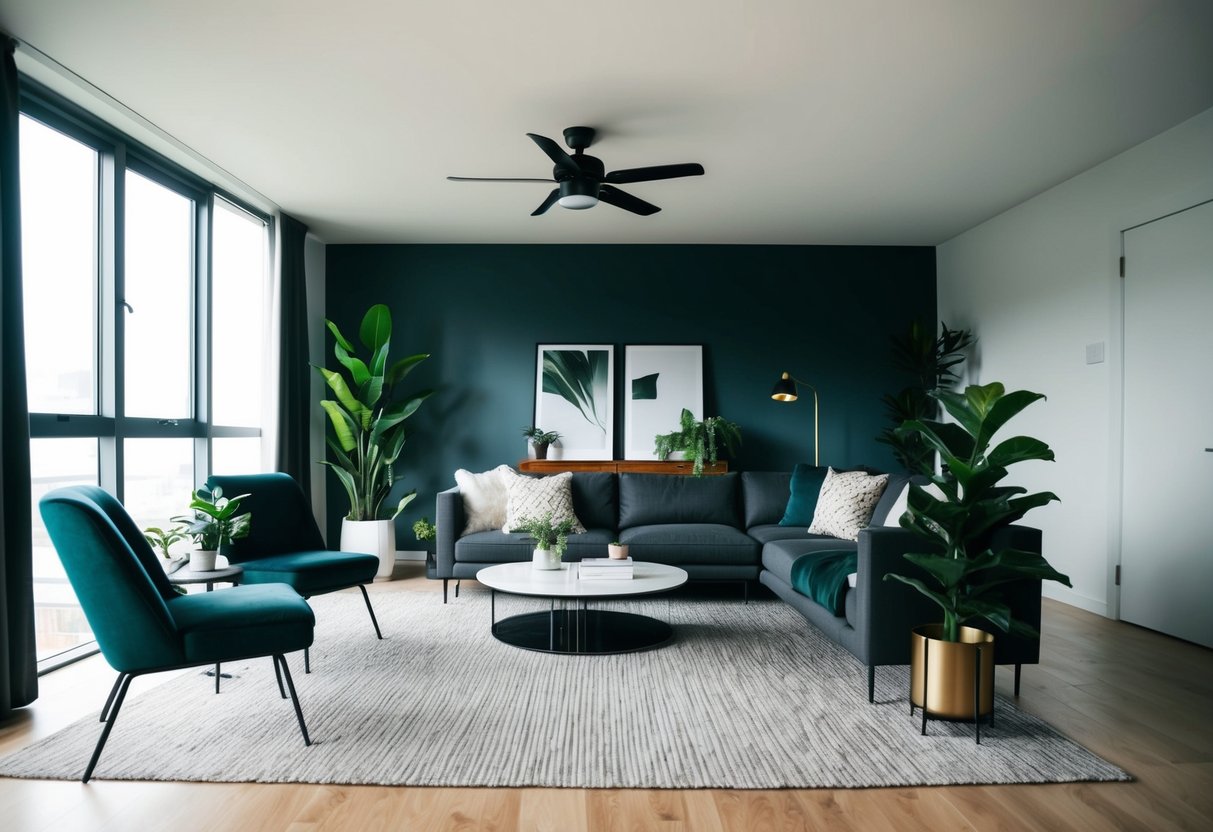
Fake plants bring a mix of savings, ease, and long life that real plants just can’t match sometimes.
You might wonder if the upfront price makes sense, or if faux plants really save you time and effort. Let’s get into the details for your wallet and your routine.
Comparing Costs: Fake Versus Real Plants
When you’re choosing between artificial and real plants, it often comes down to money.
Real plants—like succulents or leafy houseplants—might seem cheaper at first. But costs add up: soil, pots, lights, fertilizer, and sometimes replacing plants that just don’t make it.
I’ve tried raising real ferns—after killing three and buying a grow light, my wallet needed a break.
Artificial plants usually cost more upfront, but that’s it. No more monthly plant food, new soil, or replacing wilted greenery after a vacation.
Fake plants can be pricey because of quality and shipping, but if you move a lot or love redecorating, they save you cash in the long run. They don’t die if you forget them or keep the curtains closed.
Here’s a quick comparison to help you decide:
| Expense | Real Plants (annual) | Fake Plants (one-time) |
|---|---|---|
| Initial Cost | $5 – $100 per plant | $20 – $150 per plant |
| Potting & Soil | $10 – $50 | Included |
| Replacement/Dead Plants | $30+ | $0 |
| Fertilizer & Tools | $20 | $0 |
| Total (5 years) | $275+ | $20 – $150 |
Maintenance-Free Living: The Low-Effort Attraction
If you’ve ever managed to kill a cactus (yep, been there), you already know not every plant is as “easy” as the label says. Real plants actually need some regular care—watering, cleaning, trimming dead leaves, repotting, and sometimes dealing with pests. That’s a lot to juggle if you’re busy or on the road a lot.
Artificial plants basically take care of themselves. You don’t need to water them or chase sunlight, and you definitely won’t come home to a sad, wilted plant after a trip. The only real job? Dusting every few weeks. Faux succulents especially seem to gather dust in weird spots, but a quick swipe with a damp cloth sorts that out.
If you have pets or allergies, faux plants are a safer bet. There’s no soil to spill, nothing toxic for pets to chew, and zero mold. I’ve heard from a bunch of busy parents and pet owners who say fake greenery is a lifesaver—one less thing to worry about. When you don’t have to maintain plants, you actually get more time to enjoy your space.
How Long Do Faux Plants Last in Different Environments?
So, how long do artificial plants actually last? Good-quality fake plants are made to look fresh for years. Indoors, you can keep faux plants looking vibrant for at least 5 to 10 years with almost no effort. I’ve had a set of faux succulents in my kitchen for nearly seven years, and they still look pretty much new—just a rinse now and then does the trick.
If you put them in direct sunlight or outside, they can fade unless they’re UV-resistant. Newer models hold up way better, even in bright rooms or on covered patios. If you want them outdoors, look for “UV-stable” labels to avoid fading and cracking.
No matter where you put them—living room, office, or patio—most artificial plants keep their shape and color for a long time. You don’t have to think about seasons or drafts. For a lot of people, this durability and lack of hassle is a big reason to go faux, according to some recent trends in fake plants.
Health, Safety, and Practical Benefits
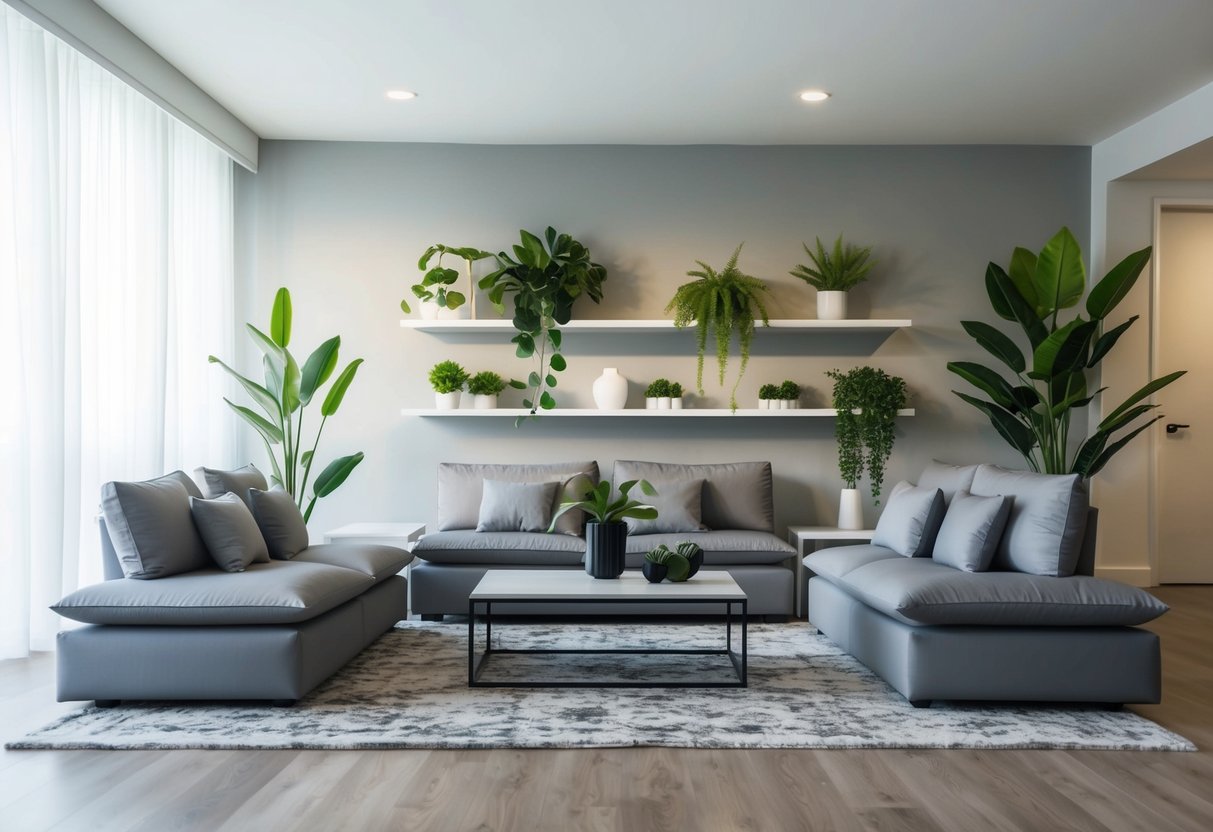
Fake plants aren’t just about looks. They actually help you skip a bunch of problems that come with real houseplants. If you have allergies or worry about pests and mold, artificial plants are a simple fix that can make your home feel safer.
Advantages for Allergy Sufferers
Do you sneeze around pollen or get itchy eyes near greenery? Real plants can set off allergies and make certain rooms uncomfortable. Artificial plants skip all that—they don’t release pollen, spores, or weird scents.
If you or your family deal with allergies, switching to artificial plants lets you enjoy green spaces without the sneezing. Even if you’re a seasonal allergy sufferer, you can keep these in any room year-round.
Kids and pets get the benefit too. Artificial plants mean no reactions from little ones poking or chewing on leaves. Lots of stores now market fake plants as allergy-friendly, so you can shop without worry.
No Pests, Diseases, or Mold Issues
Dealing with pests? No thanks. Real houseplants can bring in bugs, spider mites, and sometimes even spread disease to other plants. I once pulled up a potted fern and—surprise—tiny gnats everywhere. Not my idea of fun.
Fake plants don’t attract insects because there’s no soil or water for bugs or fungi. You also don’t have to worry about mold, even in damp spots like bathrooms. Mold can trigger asthma and make things smell musty, but artificial plants take that off your list.
Here’s a quick table to compare:
| Concern | Real Plants | Artificial Plants |
|---|---|---|
| Pests | Common | Never |
| Mold | Possible | Not an issue |
| Disease | Risk exists | No risk |
If you want a simple, low-maintenance home without surprise health issues, swapping in artificial plants is a pretty solid move.
Impact on Indoor Environment: Air Quality and Wellbeing
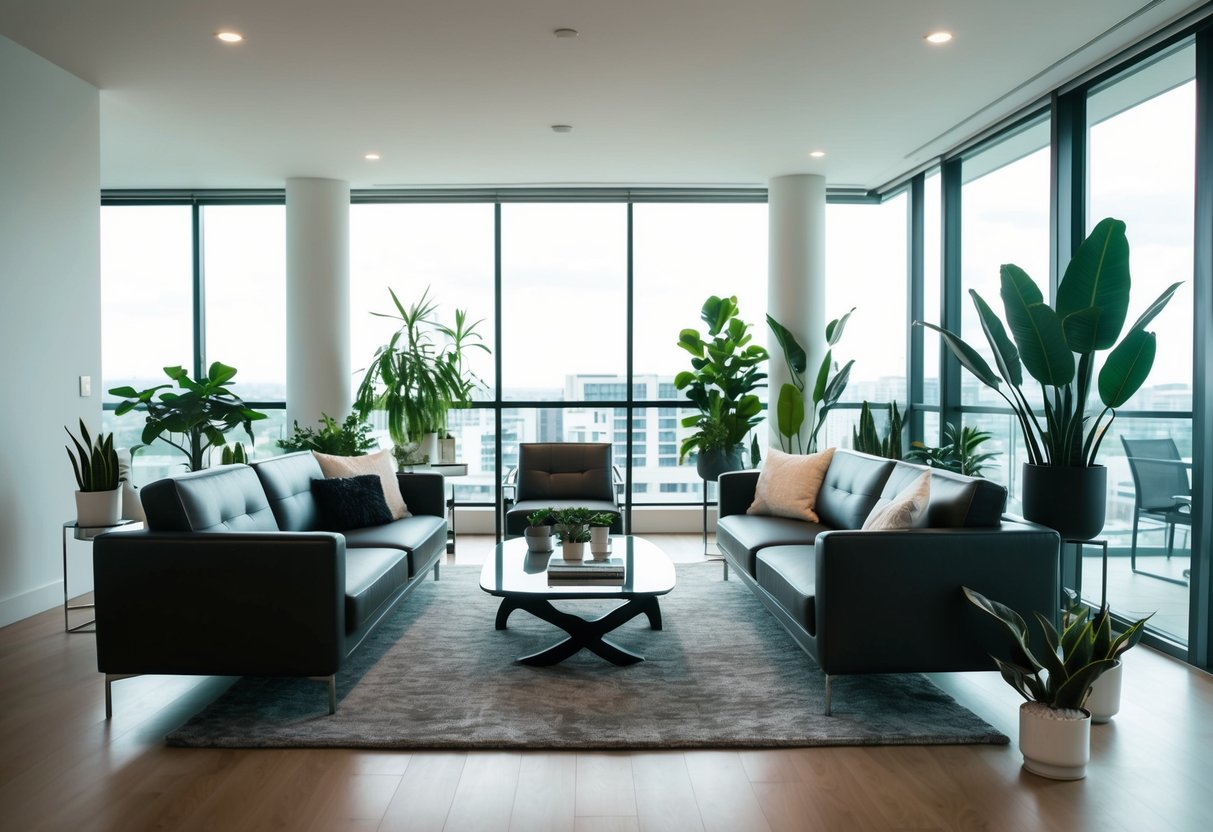
Fake plants can instantly change up your space, but when it comes to air quality and mental health, the difference between fake and real houseplants is pretty clear. Your choice affects more than just looks—it can actually impact how you feel at home.
Can Fake Plants Improve Mood and Aesthetics?
You might wonder if faux greenery really makes you feel better. Honestly, yes—especially if you’re like me and keeping plants alive is a struggle. Just seeing green, even from fake plants, can make a room feel calmer and more welcoming.
A study in the interior design world found that fake plants can still have a positive impact on emotional wellbeing. People said they felt more relaxed and happier in rooms with lifelike artificial plants.
Key benefits:
- No maintenance stress.
- Always looks good—no brown leaves.
- Allergy-friendly.
If you pick realistic faux houseplants and put them near natural light, the mood boost is almost as good as the real thing. If you forget to water plants (guilty!), fake ones keep your space cheerful all year.
Understanding Air Quality: Real Versus Faux
Let’s talk about air quality. Here’s where real and fake plants really differ. Real houseplants can absorb CO₂, release oxygen, and remove some toxins from the air. Some studies show they help with dust and mold, which is great if you have pets or kids.
Here’s a quick comparison:
| Feature | Real Plants | Fake Plants |
|---|---|---|
| Air Purification | Yes (removes some toxins, adds oxygen) | No impact |
| Allergens | Can cause some allergies | Usually allergy-friendly |
| Maintenance | Needs care and attention | No care needed |
If you want cleaner air, living indoor plants are the way to go. For looks and a mental lift, though, artificial greens still do the trick. If you’re just after a fresh vibe with zero hassle, faux plants have you covered.
Diversity of Styles: From Succulents to Statement Trees
Fake plants come in more styles now than ever before. Whether you want a tiny accent or a big, bold statement, there’s something out there for every room. The choices go way beyond the old, plastic plants that used to collect dust in waiting rooms.
Lifelike Succulents and Small Plants
Succulents—especially the fake kind—are perfect if you love the look but can’t keep up with watering or sunlight. Their chunky leaves are easier to mimic, so lots of faux succulents look real unless you get up close.
You can pop these on desks, bookshelves, or windowsills. In my place, I grouped a few fake succulents on a windowsill that barely gets any sun. Friends always ask if they’re real—seems like I fooled them.
For the most realistic vibe, pick varieties with a mix of green shades, maybe a hint of purple or red. Skip the shiny plastic pots and go for ceramic or stone planters with some soil or sand on top. That swap alone makes your fake succulents blend right in.
Quick Tips:
- Mix different types for a natural look
- Dust weekly
- Place in low-light spots where real ones wouldn’t thrive
Tall Choices: Ficus, Monstera, and More
Want something dramatic? Tall artificial plants make a big impact. Fake ficus trees, monsteras, and palms look great in corners or behind sofas. I bought a tall artificial ficus for my living room a while back, and it instantly made the space feel brighter—no watering needed.
Quality really matters. Cheaper versions have stiff leaves or trunks that just look fake. Go for artificial plants with bendable branches and a mix of leaf sizes. Some high-end ones even use real wood for trunks, which makes a huge difference.
A fake monstera or ficus in the right spot can liven up a dull corner, and renters love them since you don’t have to worry about moving heavy pots. For more tips on choosing, check out Live vs. Artificial Plants: Which to Choose for Your Home?.
Where to use tall artificial plants:
- Entryways for a welcoming vibe
- Living rooms for a splash of green
- Offices to soften up a plain spot
With the right details and placement, your faux statement trees can fool almost anyone.
Faux Greenery in Different Spaces: Home, Office, and Beyond
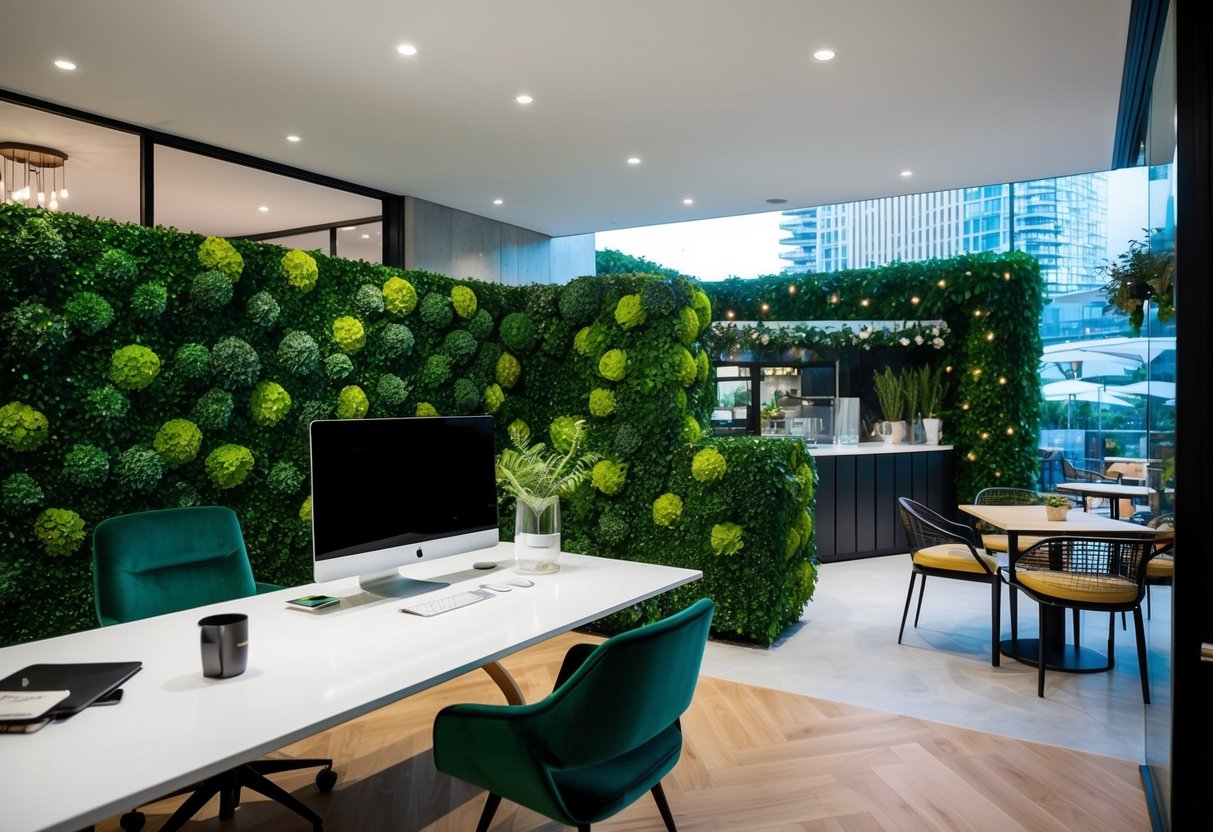
Faux plants can look great and make life easier, but where you put them matters. The right fake greenery can freshen up a living room, brighten a work desk, or hide spots where real plants just won’t grow.
Decorating Living Rooms and Bedrooms
Not sure if fake plants belong in your home? You’re definitely not alone. A lot of people worry faux greenery might look tacky or out of place. But honestly, some of today’s artificial houseplants look so real, you’d have to touch them to tell.
I put a tall faux fiddle leaf fig by my sofa after my real one dropped all its leaves. Even my mom was fooled at first. Faux plants work great in dark corners, on high shelves, or above kitchen cabinets where real plants struggle. Some folks still think all fake plants look cheap, but if you pick quality ones, mix them with real plants, and place them thoughtfully, your home will feel fresh and cozy.
Tips for Living Spaces:
- Dust weekly—dirty leaves give it away.
- Mix big and small plants for a layered effect.
- Use real ceramic or clay pots for an extra touch.
Looking for more ideas? See how others decorate with faux plants in living rooms and bedrooms.
Bringing Life to Offices and Public Areas
Workplaces need some greenery too, but who has time to water plants at work? Faux greenery gives offices a boost, even in windowless spaces. Lobbies, waiting rooms, and cubicles all look better with a touch of green and zero hassle. I once brought a fake succulent to my desk—it lasted for years and made my space feel less dull.
Popular spots for faux plants include conference tables, entryways, and bathrooms. When picking them, think about visibility and style. Go for plants that fit the vibe—ferns for calm, palms for energy. Maintenance is as easy as wiping the leaves now and then. Decor pros say thoughtful placement is key to avoiding a tacky look. Don’t crowd too many together.
Here’s a quick checklist:
- Use modern designs that match your decor
- Spread plants out for balance
- Change up arrangements every season
For more advice on using faux plants in busy or public spaces, check out tips from decor experts.
Top Picks: Popular Fake Plants and Trends for 2025
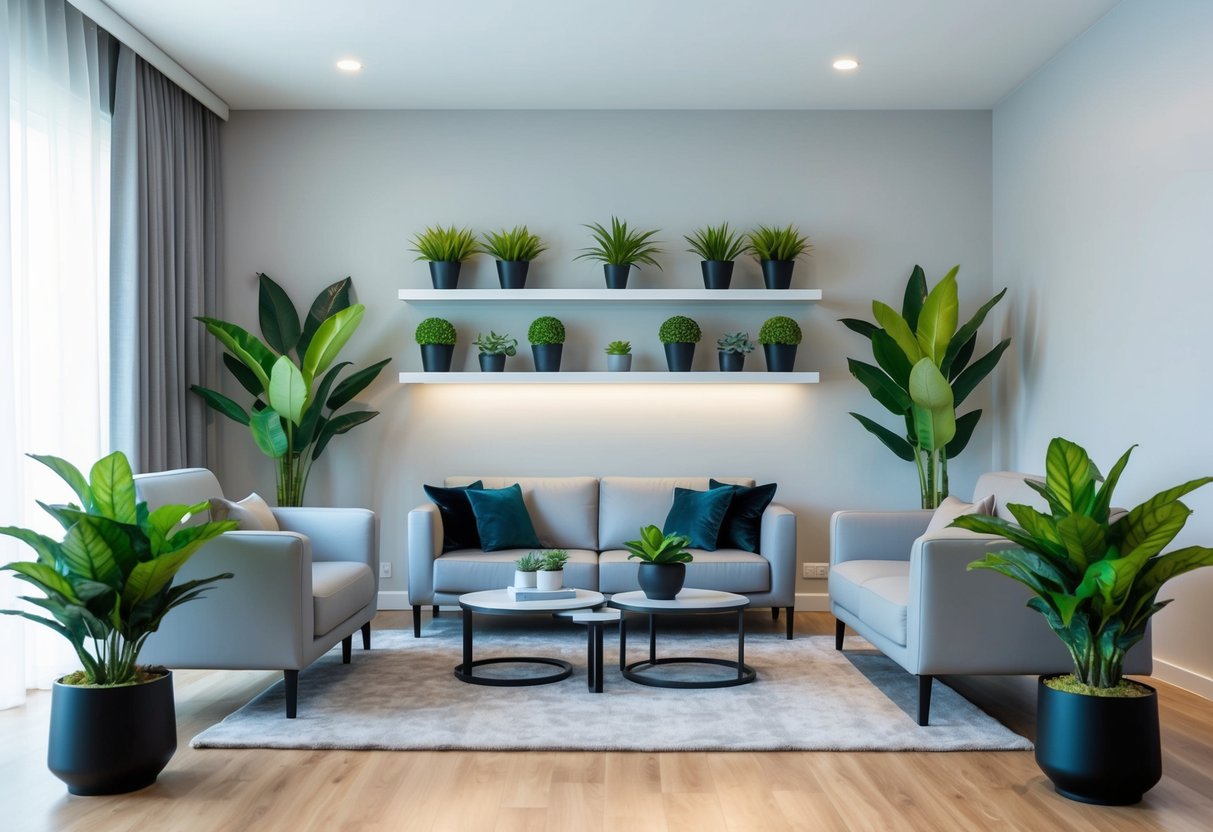
Fake plants are having a real moment in 2025. They offer style and easy upkeep, and you’ll find all sorts of designs that blend seamlessly with your décor. With just a bit of planning, you can find options that fit any space and personal taste.
Eucalyptus and Olive Trees: Rustic Charm
Eucalyptus and olive trees keep popping up on wish lists lately. These plants bring an earthy, natural vibe to your space—even if your closest brush with nature is the parking lot at the grocery store. Their soft green leaves give off a calming energy that just makes a room feel better.
Designers love using these in living rooms, bedrooms, and even kitchens. I tossed a fake eucalyptus near my desk once, and people always wanted to know if it was real. You can skip the watering and sunlight—just remember to dust the leaves now and then.
Quick reasons to choose eucalyptus and olive fake plants:
- Low maintenance: Forget about sunlight or water
- Versatile style: Works with modern, farmhouse, or rustic looks
- Available sizes: Tiny tabletop greens to six-foot floor trees
You’ll usually find faux eucalyptus and olive trees in neutral pots or baskets, which adds to their rustic charm. These days, the finishes look so real that guests usually don’t realize they’re fake. Some of the craftsmanship is wild—check out these home design trends for proof.
Palm, Birds of Paradise, and Statement Foliage
Want a bit of drama? Tall palms and birds of paradise are making a splash for 2025. These plants turn any corner into a mini vacation spot—no plant care required. Their big, fan-like leaves draw the eye and instantly perk up a dull space.
Palms aren’t just for beach houses. I stuck a tall fake palm by a plain white wall in my entryway, and honestly, it looked fresh all year. It never wilted, even when the air got bone-dry in winter.
Top reasons to include palm or birds of paradise fake plants:
- Create a focal point: Tall, leafy shapes grab attention
- Works in low-light spaces: No sun needed
- Mix and match: Pair with smaller fake plants for layers
Statement foliage fits right in with modern and boho styles. Some artificial designs look so real, guests don’t notice unless they touch the leaves. If you’re curious, see how these faux plant trends keep things modern, not tacky.
Tips for Choosing and Caring for Artificial Greenery
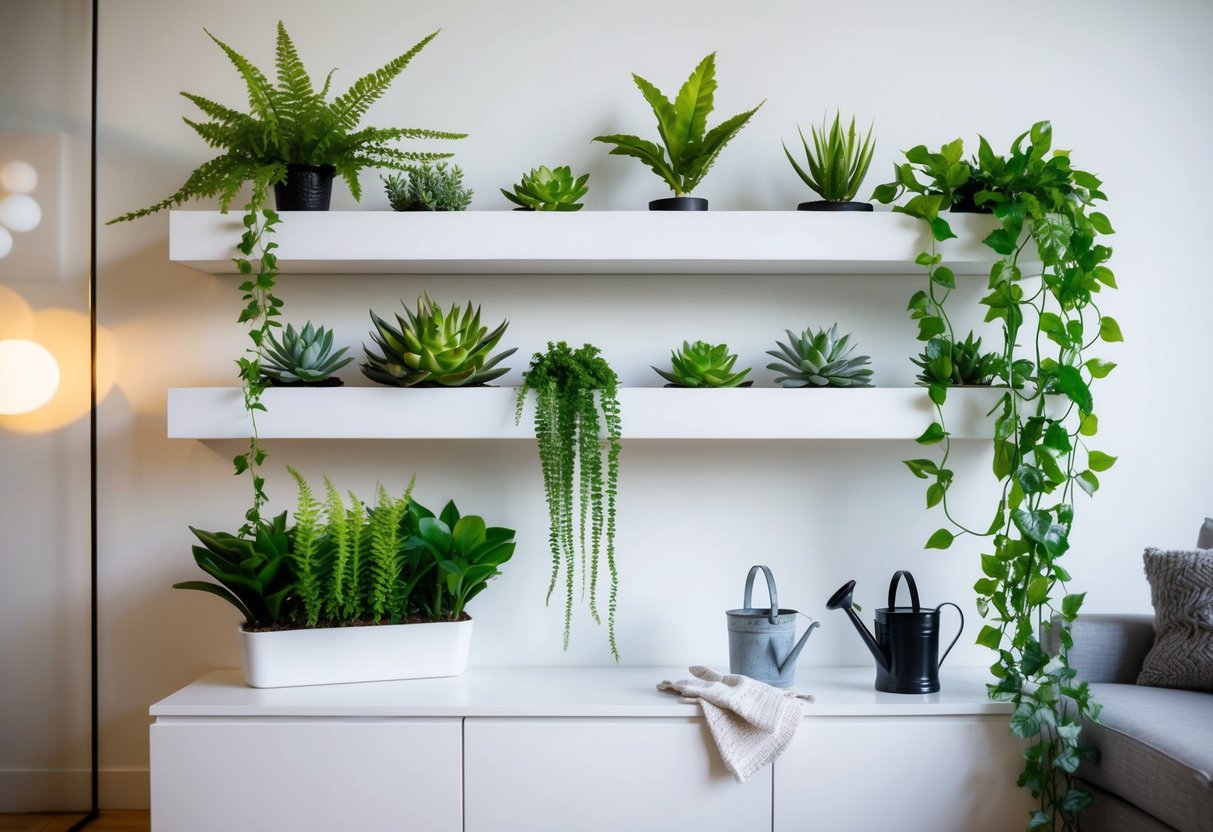
Artificial plants can brighten up your home without the stress of daily care. The trick is picking fake plants that look real and keeping them tidy so they actually add style.
If you stick to a few simple steps, you’ll dodge common decorating mistakes and get all the perks of greenery—without the mess.
Quality Materials: What to Look For
Go for artificial plants that fool the eye and last. Cheap options usually look shiny or have plastic parts that stand out. Look for leaves with natural colors, realistic shapes, and a bit of texture or fuzz.
Try touching the plant before buying. Does it feel flimsy or stiff? Good fake plants have soft, bendable stems and well-attached leaves. Silk and high-quality plastic work best. If you’re shopping online, zoom in on close-up photos and read customer reviews to see how the plant actually looks at home.
Don’t forget about the base. Plastic pots look cheap, but a ceramic, stone, or woven basket makes things look much better. I once hid a plastic pot in a thrifted basket and it totally changed the vibe. Picking the right materials keeps your greenery looking stylish, not out of place. For more advice, check out how to pick faux plants with the best colors and quality.
Placement and Styling for the Best Effect
Where you put your artificial plants really matters. Place them where real ones could thrive—by windows, in bathrooms, or on kitchen counters. Try grouping plants of different heights and shapes to keep things natural.
Dust can build up fast on fake greenery. Wipe the leaves with a damp cloth or use a soft brush once a week. I set a phone reminder so I don’t forget! Clean plants look alive; dusty ones ruin the effect.
Don’t cram too many fake plants in one spot—it looks cluttered and fake. Mix in real decor, like stones or books, to break things up. If you’re unsure about placement, move things around every couple weeks. You might spot what works best just by changing it up. For more tips, here’s a simple list from decorators about what to avoid so fake plants blend into your home decor:
- Don’t use too many identical plants in one room.
- Go for baskets, ceramic, or glass planters for style.
- Never let dust or grime build up on artificial greenery.
- Pair with real items (like wood or metal) for realism.
A few small tweaks can turn fake plants from tacky to trendy—sometimes all it takes is the right spot and a quick wipe.
Frequently Asked Questions
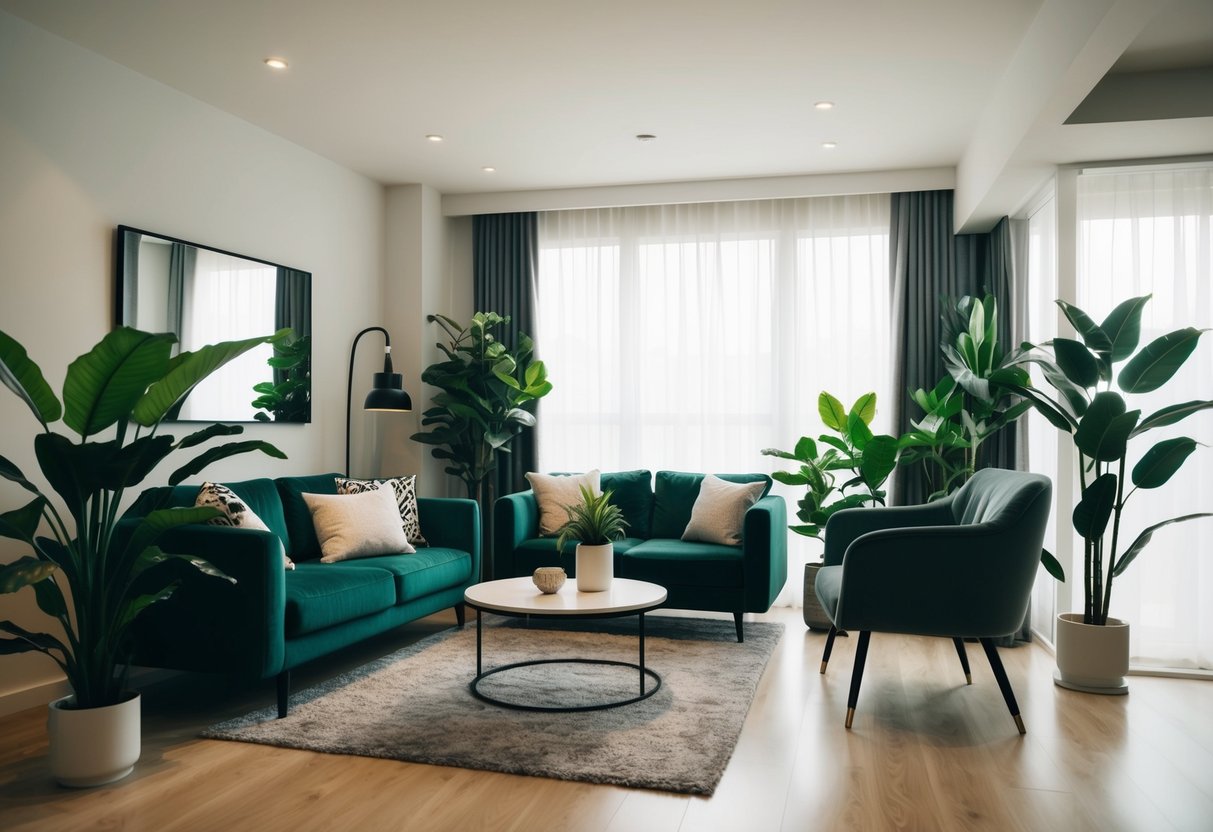
Are fake plants tacky or trendy? Your choice between artificial and real greenery shapes the whole vibe of your home. Whether you want natural touches, easy care, or just worry about authenticity, there’s something out there for you.
What are the top-notch alternatives to artificial greenery for those who want a natural touch in their space?
You don’t have to use fake plants if you love the real thing. Try low-maintenance options like snake plants, pothos, or succulents.
If your space doesn’t get much sunlight, dried flowers or preserved moss are trendy and easy-care. Even just a little live greenery brings fresh air and a calming feel.
Do lifelike artificial plants enhance the aesthetics of interior spaces without seeming unauthentic?
High-quality faux plants can blend right in if you choose carefully. The best ones use silk or good plastics that copy natural textures.
Put them in natural light or add real soil and stones so they look more convincing. Designers say well-made artificial plants look great as long as they’re clean and not obviously mass-produced.
Considering the principles of feng shui, do synthetic plants create a negative vibe in the home environment?
Fans of feng shui usually say live plants bring in positive, fresh energy, while fake plants feel “dead” and block good chi. Some even think silk greenery gets in the way of energy flow.
But others argue that if you keep your faux plants clean and place them thoughtfully, they won’t mess up your home’s vibe. You could always mix fake and real plants to balance things out.
Could incorporating imitation foliage into home decor have any detrimental effects on our well-being?
Artificial plants don’t clean the air or boost humidity the way real ones do. Some cheap fakes can give off chemical smells when they’re new.
If you’re sensitive to dust, keep fake plants clean—they attract dust faster than living ones. I had a plastic fern once that made me sneeze until I started cleaning it every week.
How do professional decorators incorporate faux flora in modern living rooms without diminishing style points?
Decorators use artificial plants as accents. Mixing fake and real plants helps everything blend together.
They put fake plants in nice pots or mix them with natural items like rocks. Most pros avoid crowding a room with too many fake plants, so it feels intentional, not overwhelming.
What factors set apart the best quality faux flora from the rest in terms of realism and aesthetic value?
When you’re shopping for faux plants, pay attention to realistic textures and natural colors. Shapes that closely copy live plants can really make a difference.
You’ll probably notice that good quality options cost a bit more. Still, they tend to last longer and honestly, they just look better.
Look for little details, like wire stems you can bend to your liking. Hand-painted leaves also add a lot of charm.
High-end fake plants really stand out. They won’t leave your space feeling fake or cheap—quite the opposite, actually.





Leave a Reply
You must be logged in to post a comment.